[Updated 3.2.2025]
Solenopsis invicta, known as the Red imported fire ant (RIFA) has been deemed in an instructive and frightening American video as the Most successful creature that has ever lived.
They are omnivorous, they are ferocious, they have an unrivalled capacity for concerted action to promote their species, and they are here. According to the Invasive Species Council fire ants are one of the world’s worst super pests. If allowed to spread, a 2016 study found the impact of fire ants would be greater than rabbits, cane toads, foxes, camels, wild dogs and feral cats combined.
When RIFA was discovered in 2001 in the Port of Brisbane and in the western suburban fringe near Ipswich we chose eradication rather than suppression. Our response has been chequered and spasmodic with periodic reviews.
Can our rickety political structure of six states and two territories loosely joined in a commonwealth defeat this determined little critter? Whenever we have paused, fire ants have advanced. After the Senate Inquiry brought down in April, once again we are pausing rather than ramping up our effort to a full court press.
Unless we ramp up our effort before we get distracted with national elections my bet is that fire ants will cut a swathe through our wildlife, disrupt our agriculture, attack our infrastructure and threaten our outdoor way of life. More likely than not, RIFA will win.
The Invasive Species Council has a Spring Briefing Note on the state of play. In the following I’ll outline where we are and suggest how we should act. Images are mainly courtesy of the Invasive Species Council.
Origin
In their native territory in the Pantanal, a large wetland at the headwaters of the Paraguay river in Argentina, Paraguay and Brazil, fire ants are preyed upon by five species of fly, which specialise in killing them. In the 1930s they invaded the United States, and, free of predators, have invaded 13 states below the snow line.
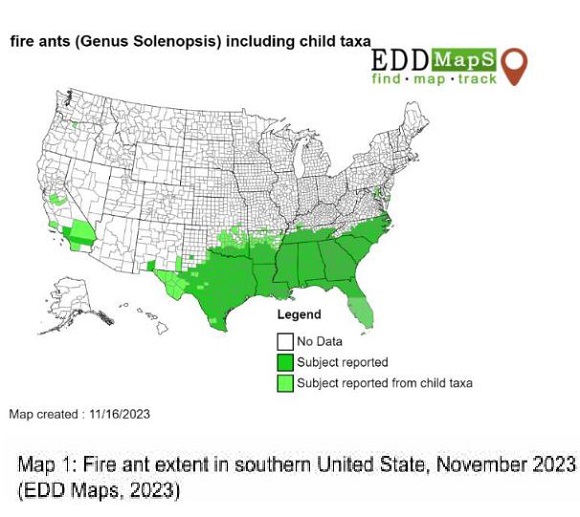
From the USA they came to Brisbane and its western suburbs, to be discovered in 2001.
Potential impact
Fire ants have the potential to spread to more than 99% of our continent and 80% of Tasmania, majorly affecting our wildlife:
- If left unchecked, fire ants will have severe ecological impacts because they reach extremely high densities. An assessment of their likely impact on 123 animals in southeast Queensland predicted population declines in about 45% of birds, 38% of mammals, 69% of reptiles and 95% of frogs. These reductions could result in possible extinctions.
Reptiles, for example, can be stung in the eyes, mouth, ears and other soft tissue, so become disabled and die. The fire ants then hollow them out through the orifices.
Eradicating RIFA is arguably the single most necessary thing we should do right now to preserve the biodiversity of our environment.
In agriculture 52 farmed crops are vulnerable. Fire ants are omnivorous. In the US grazing industry cows about to carve are put into a pretreated paddock. All grazing animals are vulnerable to blindness through stings in the eyes.
Reduction in agricultural output ranges from 10% for cropping, 20% for livestock to 40% for beef.
Infrastructure: they love electrical fields, so build nests in fuse boxes and other electrical infrastructure. Their nest can be very large beneath ground, with multiple nests connected by a maze of tunnels. They have been known to undermine driveways and roads to the point of collapse.
For our own health and safety the Invasive Species Council advises:
- When a fire ant mound is disturbed, thousands of ants swarm to the surface in an instant, repeatedly stinging the intruder. In the US, 30 to 60% of people in infested areas are stung each year. The stings are painful – the alkaloid venom causes pustules and, in some people, allergic reactions. More than 85 people in the US have died of anaphylactic shock.
2002 modelling currently being updated for Australia indicates ants would cause an extra 140,000 medical consultations and 3000 anaphylactic reactions a year. (Emphasis added)
Up to 3% of cases result in anaphylactic shock. Or your arm or leg could look really bad, or just bad:
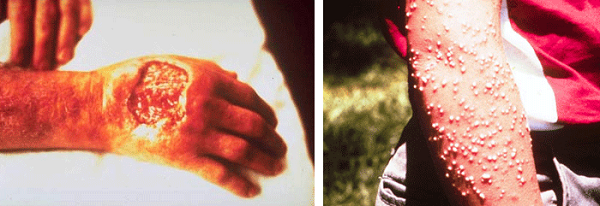
Fire ant nests vary in how they present themselves, but are typically much larger underground than the visible nest would suggest. Last year I had a close encounter with nest which was barely noticeable, with only disturbed surface soil, like this:
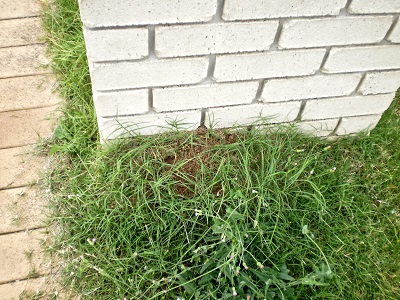
It could have been a new nest, or an opening to a tunnel between nests.
Grazing animals, pets and small children are especially at risk:

In sum our outdoor way of life will become problematic. Every state and territory will be open to them if we let them go.
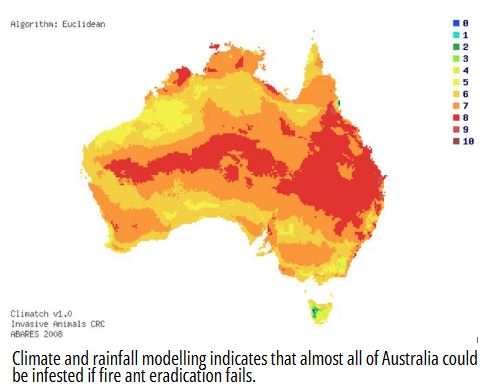
State of play
Australia was invaded by fire ants some years before they were discovered in 2001. By that time they had spread to up to 71,000 hectares in the Port of Brisbane, and in the south-west suburbs between Brisbane and Ipswich. An excellent history of what happened in subsequent decades, together with more detail on their potential impact, may be found in the Invasive Species Council’s submission to the recent Senate inquiry.
Some hundreds of millions of dollars have been spent resulting in containment rather than elimination. The following shows the current screening and containment lines:
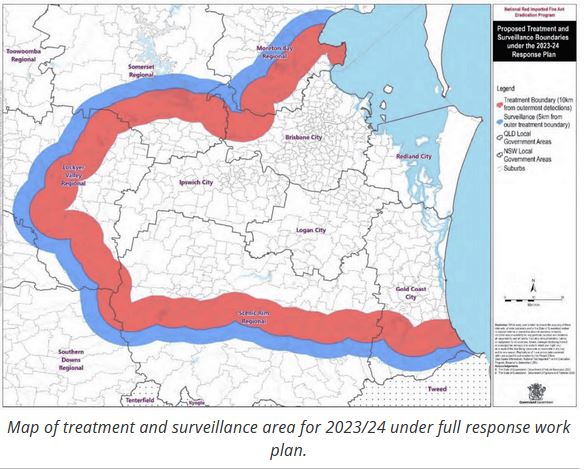
In SEQ (Southeast Queensland) the fire ant has been restricted to a spread of five kilometres per year. This compares with 48km in the US and currently 80km in China.
If the ant had spread as rapidly here as in the US it would be currently north of Mackay, west of Charleville and south of Canberra.
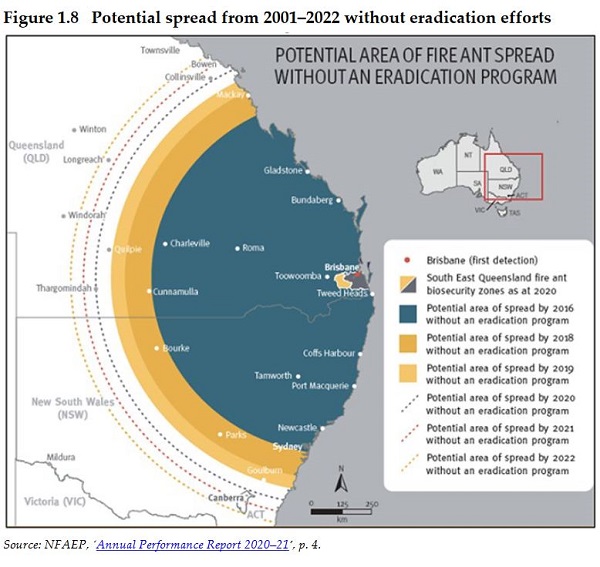
Since 2001 seven further incursions from overseas have been eradicated, including at Fremantle, Sydney and Gladstone.
In July last year following a comprehensive strategic review of the joint-funded National Fire Ant Eradication Program the Commonwealth and State Agricultural Ministers Meeting agreed to contribute $592 million for new joint-funded response plan over 2023 – 2027 as the first phase towards complete eradication by 2032. In 2023-24 unfortunately only Qld and NSW had made a budget commitment, leaving funding at around $60 million instead of $133 million.
With the Commonwealth contributing half, the other states were to fill in the remainder, graded according to population.
In the event all parties except Tasmania and SA did find the funds.
Now Fire Ant Treatment [is] Underway.
Strategy
In July 2023 Qld Agriculture Minister Don Furner put out a statement New response plan has fire ants surrounded identifying the three main elements of the strategy. I’ve taken the following from the text:
- The Commonwealth and all states need to financially back a 10-year plan to contain and roll back the fire ant spread
- Within the affected area, there needs to be suppression, especially in high infection zones eg. Inala-Logan and south (see Fire Ant Map)
- In locations of high infection there needs to be protocols and restrictions on the movement of certain goods and materials which are policed.
Here, courtesy of the Invasive Species Council, is how the perimeter eradication is meant to work:
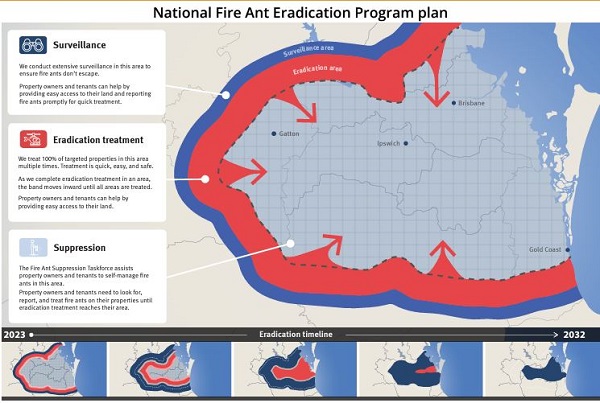
Senate Report
A Senate Committee Inquiry on fire ants was set up in October 2023 and the Report handed down in April 2024. Once again funding was short, with only The Commonwealth, NSW and Queensland making budgetary allocations at all for 2023-24. Those allocations were based on planning done up to two years earlier for the $592 million program, without consideration of inflation, increased need caused by fire ant activity, or the Senate Inquiry recommendations.
Once again the Invasive Species Council sounded the alarm, with more pictorial and other information here. Underfunding meant that the northern boundary of the infested area could not be treated, so the fire ants duly headed for the Sunshine Coast hinterland.
The Senate Inquiry Recommendations called for an urgent review of the National Fire Ant Eradication Program to assess the true level of funding required, and that all governments make a whole-of-government response to reflect the seriousness of red imported fire ants on all aspects of Australian life, including health, tourism, agriculture, and the environment. All governments must ensure continuity of funding. No backsliding allowed – this enemy is relentless!
Also:
[only] $37.5 million has been allocated to Councils for fire ant responsibility regarding suppression efforts from 1 July. This funding falls woefully short of what is needed for Councils to keep this issue under control.
Commonwealth funding is needed to assist Queensland’s affort.
I understand funding of the perimeter eradication program has been now been rectified so that 300,000 hectares are to get three treatments in the coming year. However, the fire ant population within the affected area is quite frankly exploding, which increases the likelihood of infection being carried outside the containment horseshoe to anywhere in Australia.
Moreover, there is no sign whatever of action on the other Senate recommendations as such, which I’ll summarise as follows, adapted from the Invasive Species Council:
- An alternative statutory independent agency or commission for fire ant eradication program delivery
- A rapid review of current funding to ensure it is sufficient and uninterrupted to get the job done
- Greater eradication program transparency and a public awareness campaign
- An increased investment in research on emerging fire ant eradication techniques, in particular establishing a Cooperative Research Centre
- More resources for local treatment of fire ants in the infestation zone
- Increased compliance to control fire ant movements in freight.
None of that has happened. Now we have Fresh opportunities for environmental biosecurity reform as new Minister for Agriculture appointed.
Have not heard from her so far.
Avenues for lobbying
Here’s a guide from Oxfam on Writing to your MP. I’m told it is best to ring first, if possible.
The ministers for agriculture have the national carriage for fire ants. Here’s The Hon. Julie Collins MP, Minister for Agriculture, Fisheries and Forestry. You can find other ministers from this page, but I would suggest at least The Hon. Tanya Plibersek MP, Minister for Environment and Water, plus The Hon. Dr. Jim Chalmers MP, Treasurer.
Other MPs, including the cross bench, can be found starting on this page.
In states, beyond treasury, environment and agriculture, it may be worth contacting those with responsibility in schools, tourism, local government and more.
Then there is the Australian Environmental Pest Managers Association (AEPMA)
The AEPMA should include Fire ants on their main page Find a Pest Manager Here facility.
Visit by American expert
This Invasive Species Council webinar, chaired by CEO Andrew Cox, featured visiting Texas entomologist Dr Robert Puckett together with Dr Rachel Chay, Queensland Chief Biosecurity Officer, overseeing Australia’s national fire ant eradication program and Reece Pianta, Invasive Species Council advocacy manager and fire ant specialist.
Highlights for me included Dr Puckett, describing how over the years everyone gets bitten multiple times in the infested states. The poison bio-accumulates, so the reaction can become more severe as time goes by.
As a father, he described how you know your small child will be bitten, but you do not know whether they will experience anaphylactic shock, as up to three per cent of people do.
Already in Logan and elsewhere small children in strollers are seen with sting marks on their limbs.
Dr Chay explained that the first you know when you step on a nest you did not see is that you have over 100 stings.
Reece Pianta explained that at a barbecue they held in Cedar Grove they put out eight pairs of sausages with chips in a grassy area with no visible nests. Checking later they found fire ants feeding on all but one.
Dr Puckett thinks we can achieve our aim of total eradication of RIFA. We are the only country trying, out of about a dozen infected. However, we will need to be at the top of our game, and keep it up without pause for ten years.
Further Information
National Fire Ant Eradication Program
Biosecurity Queensland within the Queensland Department of Agriculture and Fisheries currently delivers National Eradication Program.
Australia Institute Report: Fire ants to kill 6 Queenslanders and cost households $188 million annually if not eradicated
Further links
Fire ant suppression underfunding puts Sunshine Coast at risk (31 May 2024)
Calls to better resource National Fire Ant Eradication Program after nearly 40,000 reported sightings (18 May 2024)
Senate inquiry warns of ‘disastrous’ fire ant consequences without urgent action
Red imported fire ants in Australia Don’t Let This Come Back to Bite Us
Update Feb 2025
I’m a bit late on this, but last October the Federal Government gave a formal response to the Senate Inquiry.
Many found the response disappointing, but its main virtue is that it sets up a structure that can be replicated to meet any future challenge of similar magnitude.

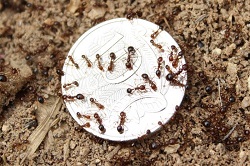
I’ve altered this post today, and will need to alter it more over the next few days. Further information has become available. In short all states and territories are once again on board, but the recommendations of the Senate inquiry are stuck in the system.
I’ll also add some addresses that might be useful for lobbying.
This is, hopefully, a fairly final form. I’ll need to get it checked by an expert.
‘ZeroCAL’ cement production process takes CO2 out of the equation